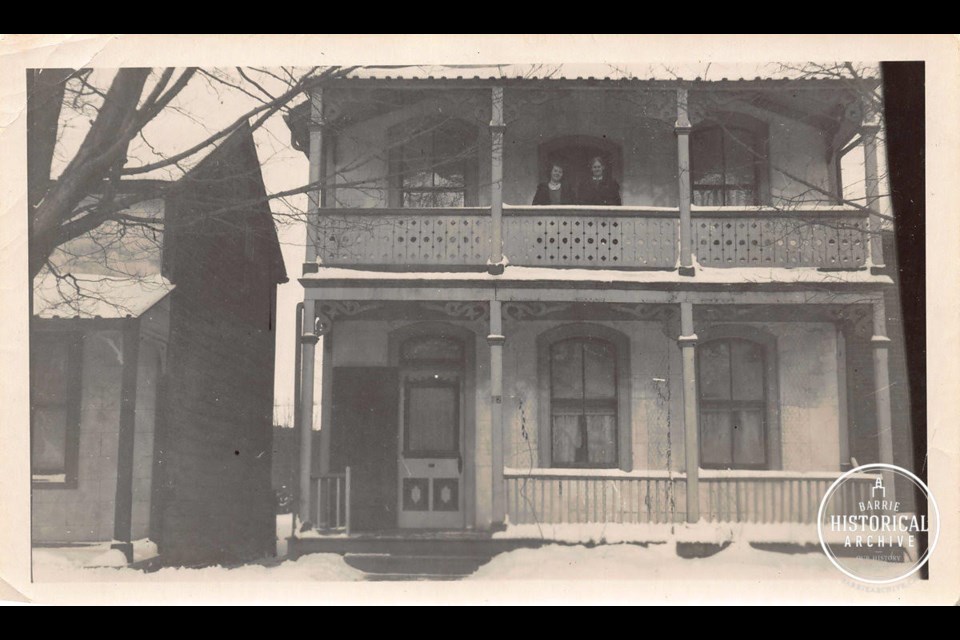“It’s Barrie’s slum and we’re stuck with it.”
Those were the words of columnist, Stephen Nicholls, in a full-page pictorial spread he wrote for the Barrie Examiner on May 10, 1980. He wasn’t exaggerating.
It’s hard to imagine today, with a modern library and adjacent tidy parking lot, but the area one block north of Collier St. was described many times as an eyesore and a blight upon the city, and not all that long ago.
It was not always this way.
In 1871, the area bordered by Clapperton, Worsley, McDonald and Owen Sts. was owned by a Mr. J. Edwards who had it surveyed and divided into rather small lots. He further added a network of laneways that ran behind the homes, and their pattern led to the area being known locally as the H-Block.
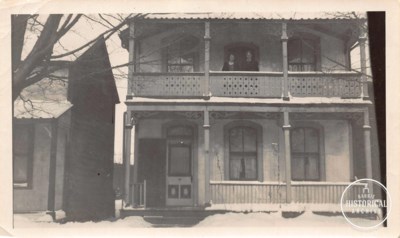 The Hart family home at 52 Worsley St., near the present day library site, circa 1925. Photo courtesy of Barrie Historical Archive.
The Hart family home at 52 Worsley St., near the present day library site, circa 1925. Photo courtesy of Barrie Historical Archive.Heritage Barrie, in its H-Block and Court Hill self-guided tour brochure of 2000, beautifully describes the quaint, working class neighbourhood as it was in better years.
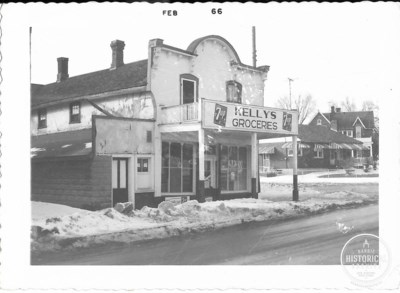 Kelly's Store on the corner of Owen and McDonald Sts. 1966. Photo courtesy of Barrie Historical Archive.
Kelly's Store on the corner of Owen and McDonald Sts. 1966. Photo courtesy of Barrie Historical Archive.“Part of the appeal of the H-Block was that each resident could have a small yard as well as a share of the common areas along the laneways where the out-buildings and later garages were built. Most of the dwellings on the block and around the perimeter were one or one and a half storey, frame or log structures clad with roughcast plaster or clapboard. There were a number of wood shanties and a scattering of brick houses. The area was popular with workers and tradespeople. Many long-time residents of Barrie recall the block being covered in flower and vegetable gardens and an apple orchard.”
The rapid decline of the H-Block began in the late 1970s when a development company began buying up the properties in order to demolish them and build a multi-million-dollar condominium project known as Kempenfelt Place.
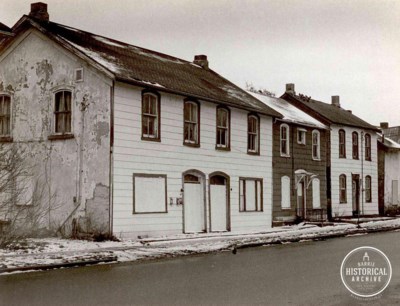 Looking north from the corner of Owen and Worsley Sts. 1979. Photo courtesy of Barrie Historical Archive.
Looking north from the corner of Owen and Worsley Sts. 1979. Photo courtesy of Barrie Historical Archive.The company, reported in the Barrie Examiner article as Mendhammer Holdings Ltd., soon defaulted on the mortgage while the principal developer, Ed Jennings, seemed to have skipped town in 1979.
This left most of the houses in the H-Block sitting empty. It wasn’t very long before the vacant homes became the targets of vandals and ‘house-strippers’ who began tearing out any salvageable building materials.
Next came squatter tenants who built fires to keep warm, and partiers using drugs and alcohol, all of which resulted in lots of damage, large amounts of garbage and a generally unsafe area to be in.
The City of Barrie was under a lot of pressure from its residents to do something about this very ugly, decrepit and dangerous four-acre block, but largely remained powerless as the land was still officially owned by the decamped developer.
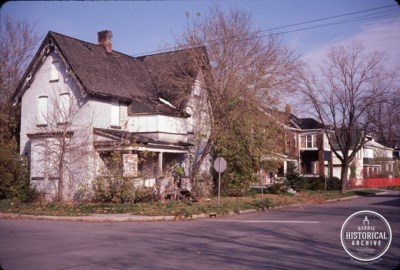 Looking east from the corner of Clapperton and Worsley Sts. 1981. Photo courtesy of Barrie Historical Archive.
Looking east from the corner of Clapperton and Worsley Sts. 1981. Photo courtesy of Barrie Historical Archive.This sticking point was written in the City of Barrie Act which gave the city power to demolish buildings such as these, but only after they had been vacant for at least three years. The H-Block houses, in 1980, had been vacant for not quite two years. All Barrie could do was barricade the laneways into the block, increase police patrols and swallow the clean-up bills until the issue could be permanently resolved.
For its part, the developer tried in vain to sell its Kempenfelt Place project to someone else, but as we can all see, that fell through.
I first saw what remained of the H-Block in 1982. By then, it was just a grassy field dotted with a couple of hold-out houses. I had heard that the area was notorious, but all I saw then was a peaceful meadow and I wondered at its reputation.
Seeing the collection of H-Block photographs on the Barrie Historical Archive was the first time I realized how unfortunate the area had become, just a short time before my arrival.
It is one thing to buy up a collection of houses, once the centre of family life and happy childhood memories, for some kind of improvement or community-enriching development, but to let them sit and rot this way was a disgrace. It must have been very difficult for former H-Block residents, neighbours and city officials to watch the decay of this neighbourhood unfold.
The story has a happy ending though.
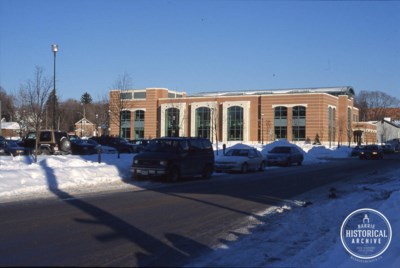 The Barrie Public Library at 60 Worsley St., much as it looks today. 1999. Photo courtesy of Barrie Historical Archive.
The Barrie Public Library at 60 Worsley St., much as it looks today. 1999. Photo courtesy of Barrie Historical Archive.All remnants of this unpleasant period of time have since disappeared from the H-Block. A lovely library stands on the eastern edge of the old block, complete with lofty ceilings and cozy nooks, huge sunny windows and an airy roof garden.
Few would believe that ugliness ever existed here before.
Each week, the Barrie Historical Archive provides BarrieToday readers with a glimpse of the city’s past. This unique column features photos and stories from years gone by and is sure to appeal to the historian in each of us.
